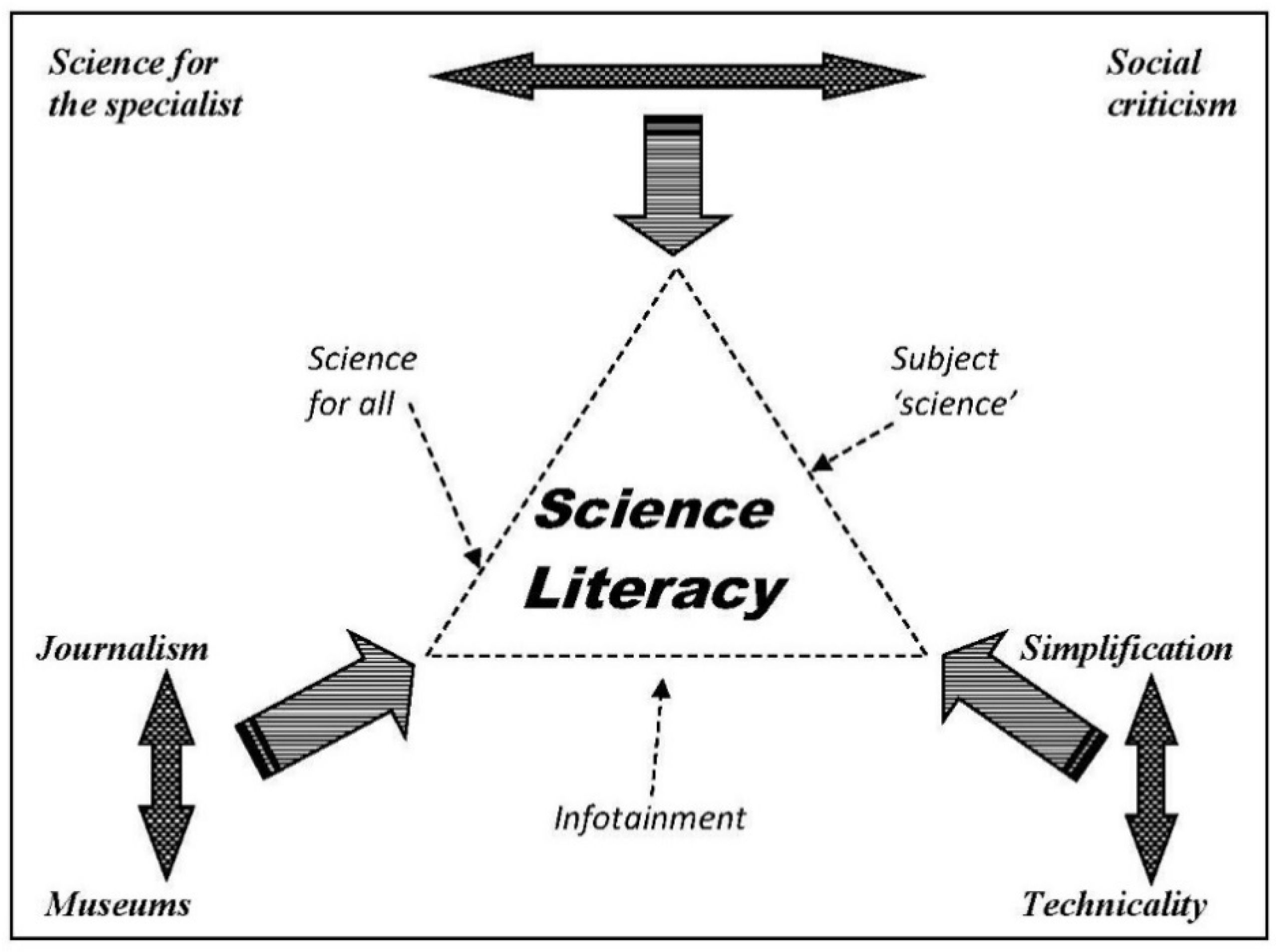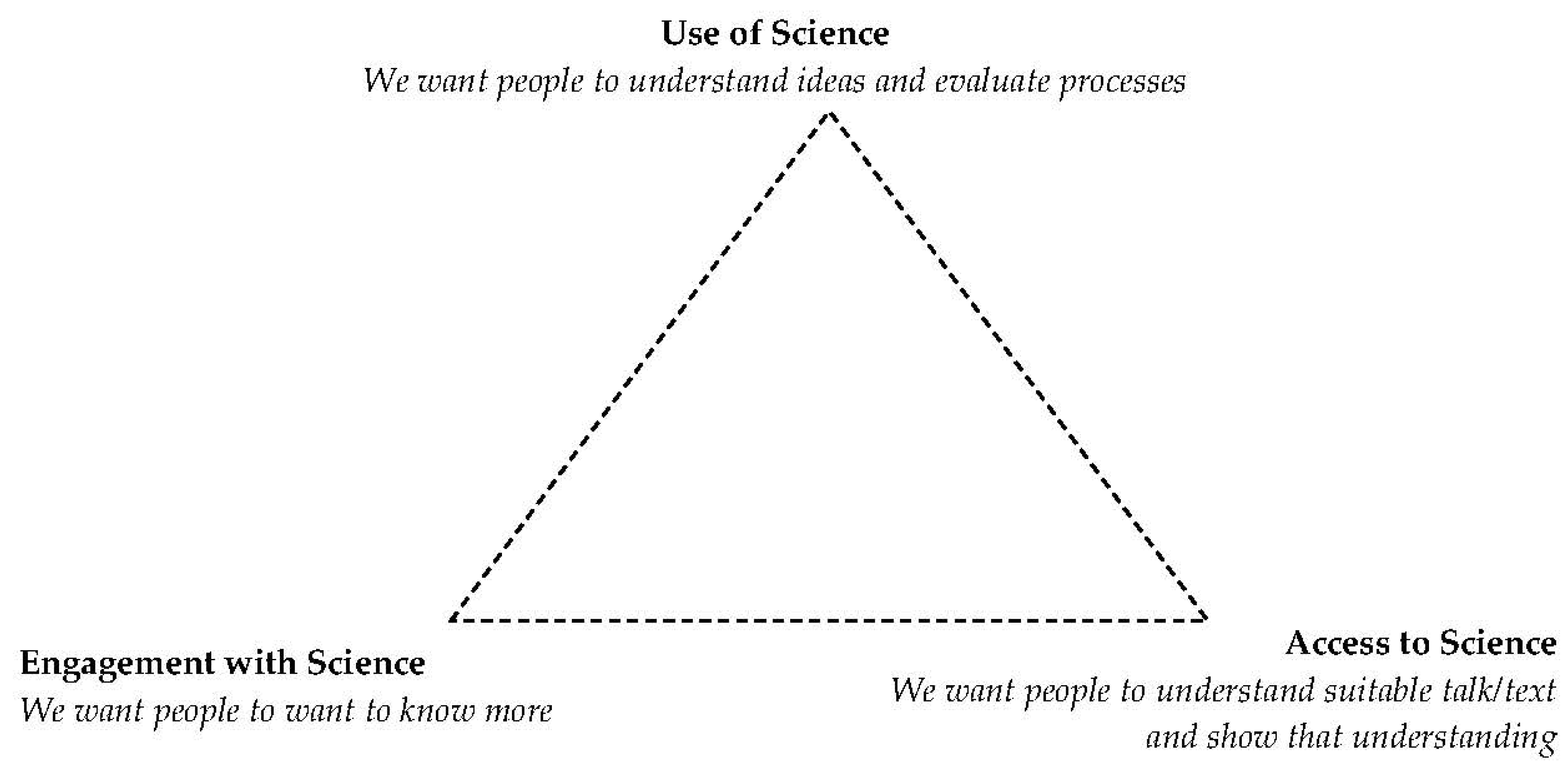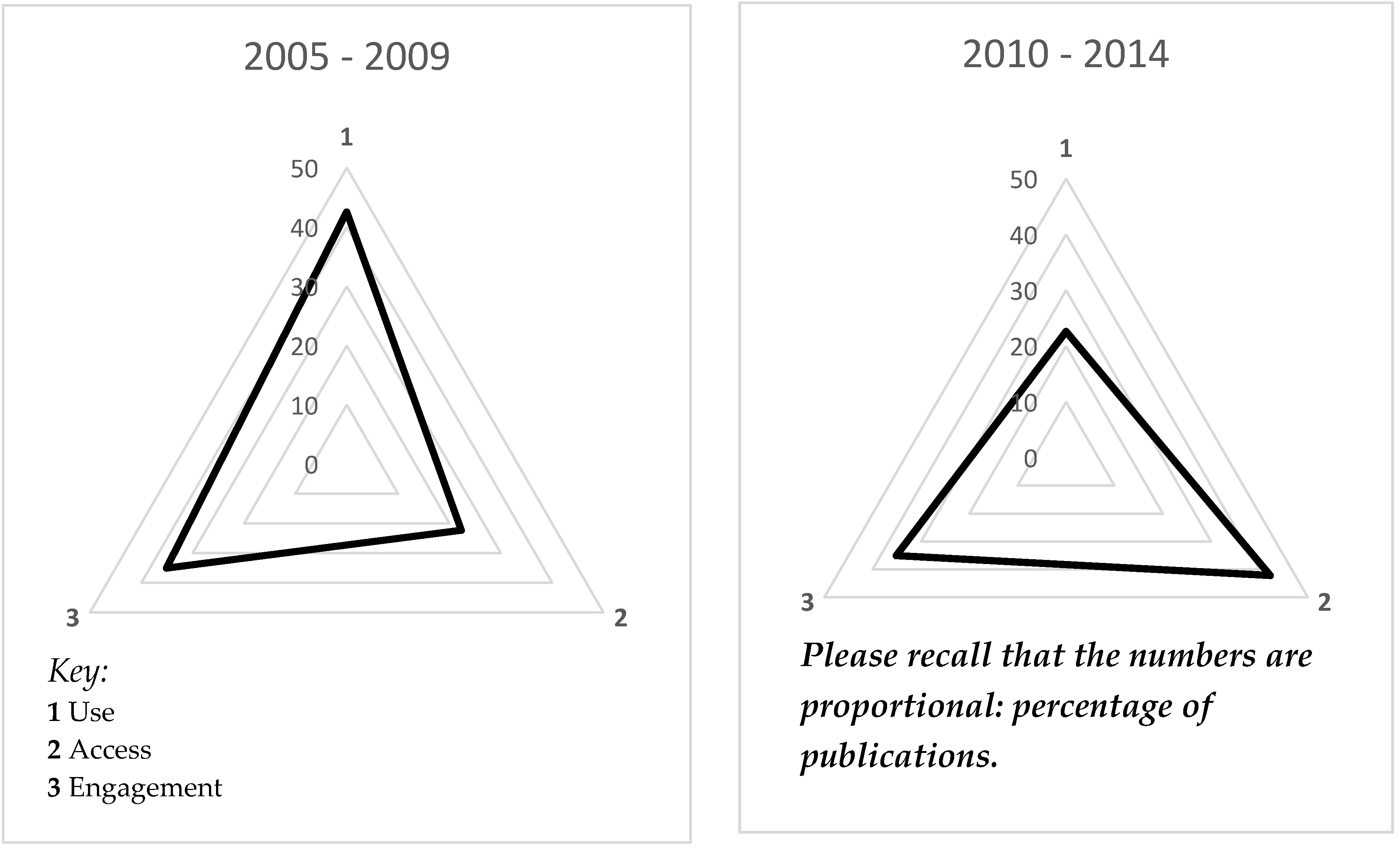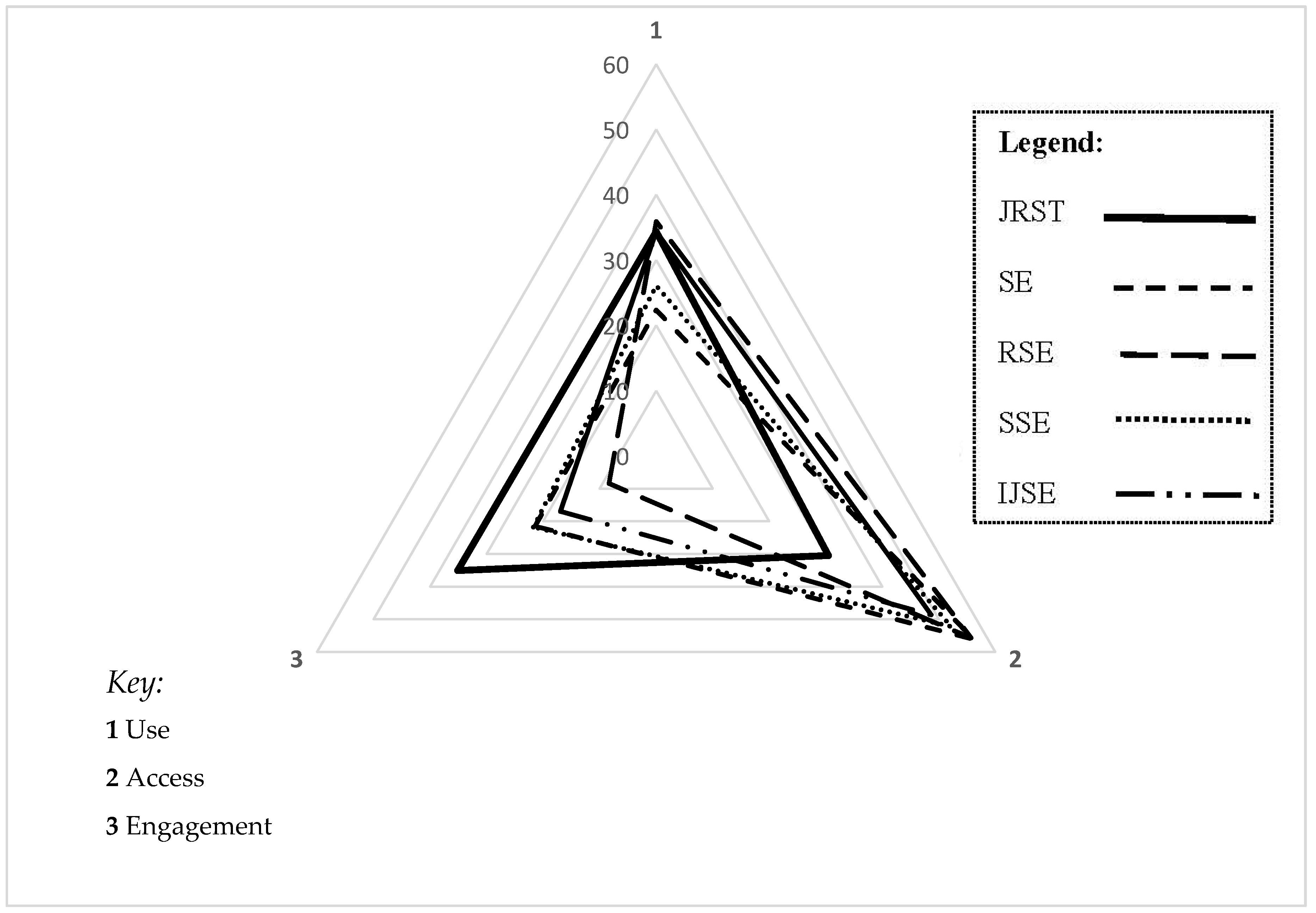‘Scientific Literacy’: An Exercise in Model Building
Abstract
1. Literacy as a Power Word
The ASTA rejects in the strongest possible terms the notion that the term ‘literacy’ is one that should be preserved only for use in the study of English and it’s Literacy Continuum. The term has been increasingly and successfully employed across a broader range of curriculum areas. Apart from ‘scientific literacy’, the applications to ‘financial literacy’, ‘numerical literacy’, ‘visual literacy’ and others are commonplace and widely understood and accepted in education circles.[1]
2. Expanding Notions of Literacy
Various assessments have shown that secondary school students in the United States are not reading well enough to succeed in careers or college, with particular concerns about their readiness to participate in the so-called STEM (Science–Technology–Engineering–Mathematics) professions.[21]
3. The Role of Models in Intellectual Work
4. The Case of Science Literacy
5. Mapping Wider Tensions
6. Conceptual Modelling: An Attempt at Clarity
7. An Empirical Challenge
- How does the change in JRST pattern compare to that in the International Journal of Science Education (SE: the other larger journal)?
- Does the change represent publication lag or editorial policy?
- Is there a jurisdiction effect?
- Has the apparent contrast between JRST and RSE persisted since 2014?
8. So What Is ‘Discipline Literacy’?
9. Potential and Limitations of an Initially Successful Model
Author Contributions
Funding
Conflicts of Interest
References
- Turnbull, P. ASTA Response to the National Curriculum Board Science Framing Paper. 23 February 2009. Available online: http://www.asta.edu.au/freestyler/files/ASTA%20response%20to%20the%20national%20curriculum%20board%20final.doc (accessed on 5 July 2009).
- Norris, S.P.; Phillips, L.M. How literacy in its fundamental sense is central to scientific literacy. Sci. Educ. 2003, 87, 224–240. [Google Scholar] [CrossRef]
- Spires, H.; Kerkhoff, S.N.; Graham, A.C.K.; Thompson, I.; Lee, J.K. Operationalizing and validating disciplinary literacy in secondary education. Read. Writ. 2018, 31, 1401–1434. [Google Scholar] [CrossRef] [PubMed]
- Freebody, P.; Luke, A. Literacy as engaging with new forms of life: The four roles model. In The Literacy Lexicon, 2nd ed.; Anstey, G.B.M., Ed.; Pearson: Sydney, Australia, 2002; pp. 51–65. [Google Scholar]
- Gee, J.P. What Video Games have to Teach Us about Learning and Literacy; Palgrave Macmillan: New York, NY, USA, 2003. [Google Scholar]
- Lachuk, A.J. The socio-historical mandate for Literacy and Education in the Rural South: A narrative perspective. Res. Teach. Engl. 2015, 50, 84–110. [Google Scholar]
- Gould, S.J.; Marshall, S.; Scheppler, J.A.; Palmisano, M.J. Science Literacy for the Twenty-First Century; Prometheus Books: Amherst, NY, USA, 2003. [Google Scholar]
- Granville, S.; Laura, D. Thinking about thinking: Integrating self-reflection into an academic literacy course. J. Engl. Acad. Purp. 2005, 4, 99–118. [Google Scholar] [CrossRef]
- Knain, E. Identity and genre literacy in high-school students’ experimental reports. Int. J. Sci. Educ. 2005, 27, 607–624. [Google Scholar] [CrossRef]
- Ross, K.M.; Joseph, L.M. Effects of word boxes on improving students’ basic literacy skills: A literature review. Prev. Sch. Fail. Altern. Educ. Child. Youth 2018, 63, 43–51. [Google Scholar] [CrossRef]
- Semali, L. Literacy in Multimedia America: Integrating Media Education across the Curriculum; Falmer Press: New York, NY, USA, 2000. [Google Scholar]
- Roser, M.; Ortiz-Ospina, E. Literacy. Our World in Data. 2018. Available online: https://ourworldindata.org/literacy (accessed on 15 August 2019).
- Pantaleo, S. Language, literacy and visual texts. Engl. Educ. 2015, 49, 113–129. [Google Scholar] [CrossRef]
- Barton, G. The arts and literacy: What does it mean to be arts literate? Int. J. Educ. Arts 2013, 14. Available online: http://www.ijea.org/v14n18/ (accessed on 15 August 2019).
- Gordon, J. Reading from nowhere: Assessed literary response, practical criticism and situated cultural literacy. Engl. Educ. 2018, 52, 20–35. [Google Scholar] [CrossRef]
- Neitzel, S.M.; van Zwieten, P.A.M.; Hendriksen, A.; Duggan, D.; Bush, S.R. Returning information back to fishers: Graphical and numerical literacy of small-scale Indonesian tuna fishers. Fish. Res. 2017, 196, 96–105. [Google Scholar] [CrossRef]
- Seemann, K.; Talbot, R. Technacy: Towards a holistic understanding of technology teaching and learning among Aboriginal Australians. Prospects 1995, 25, 761–775. [Google Scholar] [CrossRef]
- Gerrans, P.; Heaney, R. The impact of undergraduate personal finance education on individual financial literacy, attitudes and intentions. Account. Financ. 2019, 59, 177–217. [Google Scholar] [CrossRef]
- Shanahan, T.; Shanahan, C. Teaching disciplinary literacy to adolescents: Rethinking content-area literacy. Harv. Educ. Rev. 2008, 78, 40–59. [Google Scholar] [CrossRef]
- NGA/CCSSO. Common Core State Standards for English language Arts & Literacy in History/Social Studies, Science, and Technical Subjects. 2010. Available online: http://www.corestandards.org/assets/CCSSI_ELA%20Standards.pdf (accessed on 15 August 2019).
- Shanahan, T.; Shanahan, C. What Is Disciplinary Literacy and Why Does It Matter? Top. Lang. Disord. 2012, 32, 7–18. [Google Scholar] [CrossRef]
- Anstey, M.; Bull, G. The Literacy Labyrinth, 1st ed.; Prentice Hall: Sydney, Australia, 1996. [Google Scholar]
- Samarapungavan, A.; Westby, E.L.; Bodner, G.M. Contextual epistemic development in science: A comparison of chemistry students and research chemists. Sci. Educ. 2006, 90, 468–495. [Google Scholar] [CrossRef]
- Wade-Jaimes, K.; Demir, K.; Qureshi, A. Modeling strategies enhanced by metacognitive tools in high school physics to support student conceptual trajectories and understanding of electricity. Sci. Educ. 2018, 102, 711–743. [Google Scholar] [CrossRef]
- Thompson, C. Sea People: The Puzzle of Polynesia; William Collins: London, UK, 2019. [Google Scholar]
- Levison, M.; Ward, R.G.; Webb, J.W. The Settlement of Polynesia: A Computer Simulation; University of Minnesota Press: Minneapolis, MN, USA, 1973. [Google Scholar]
- Becker, W.; Conroy, S.; Djurdjevic, E.; Goss, M. Crying is in the eye of the beholder: An attribution theory framework of crying at work. Emot. Rev. 2018, 10, 125–137. [Google Scholar] [CrossRef]
- Pierson, A.E.; Clark, D.B. Engaging students in computational modeling: The role of an external audience in shaping conceptual learning, model quality, and classroom discourse. Sci. Educ. 2018, 102, 1336–1362. [Google Scholar] [CrossRef]
- Wilkerson-Jerde, M.; Wagh, A.; Wilensky, U. Balancing curricular and pedagogical needs in computational construction kits: Lessons from the Delta Tick Project. Sci. Educ. 2015, 99, 465–499. [Google Scholar] [CrossRef]
- Shim, S.-Y.; Kim, H.-B. Framing negotiation: Dynamics of epistemological and positional framing in small groups during scientific modeling. Sci. Educ. 2017, 102, 128–152. [Google Scholar] [CrossRef]
- Schuchardt, A.M.; Schunn, C.D. Modeling scientific processes with mathematics equations enhances student qualitative conceptual understanding and quantitative problem solving. Sci. Educ. 2016, 100, 290–320. [Google Scholar] [CrossRef]
- Ellis, N.C. Cognition, corpora and computing: Triangulating research in usage-based language learning. J. Res. Lang. Stud. 2017, 67, 40–65. [Google Scholar] [CrossRef]
- O’Toole, J.M.; Freestone, M.; McKoy, K.; Duckworth, B. Types, topics and trends: A ten-year review of research journals in Science Education. Educ. Sci. 2018, 8, 73. [Google Scholar] [CrossRef]
- Layton, D.; Davey, A.; Jenkins, E.W. Science for specific social purposes (SSSP): Perspectives on adult literacy. Stud. Sci. Educ. 1986, 13, 27–52. [Google Scholar] [CrossRef]
- Zen, E. Scientific literacy: What is it, why is it important and what can scientists do to improve the situation? Aust. Sci. Teach. J. 1992, 38, 18–23. [Google Scholar]
- Lively, B.A.; Pressey, S.L. A method for measuring the ‘vocabulary burden’ of textbooks. Educ. Adm. Superv. 1923, 9, 389–398. [Google Scholar]
- Cleland, B.; Evans, R. Learning English through general science; Longman Cheshire: Melbourne, Australia, 1984. [Google Scholar]
- Swales, J.M. Writing Scientific English; Nelson: London, UK, 1971. [Google Scholar]
- Kennedy, A. Whatever the Weather, a Course Set for Terror; Sydney Morning Herald: Sydney, Australia, 2000; p. 1. [Google Scholar]
- Walker, D. There are no Votes in Poor Site Design; Sydney Morning Herald; Tech Economy: Sydney, Australia, 21 November 2000; p. 5. [Google Scholar]
- Cambourne, B. The Whole Story: Natural Learning and the Acquisition of Literacy; Ashton Scholastic: Auckland, New Zealand, 1988. [Google Scholar]
- Halliday, M.A.K. An Introduction to Functional Grammar, 2nd ed.; Edward Arnold: London, UK, 1994. [Google Scholar]
- Cope, B.; Kalantzis, M. (Eds.) Multiliteracies: Literacy Learning and the Design of Social Futures; Routledge: London, UK, 2000. [Google Scholar]
- Smagorinsky, P. Disciplinary Literacy in English Language Arts. J. Adolesc. Adult Lit. 2015, 59, 141–146. [Google Scholar] [CrossRef]
- Laugksch, R.C. Scientific literacy: A conceptual overview. Sci. Educ. 2000, 84, 71–94. [Google Scholar] [CrossRef]
- Prain, V.; Waldrip, B. Representing science literacies: An introduction. Res. Sci. Educ. 2010, 40, 1–3. [Google Scholar] [CrossRef]
- Bodmer, W. Scientific literacy for health and prosperity. Sch. Sci. Rev. 1989, 70, 9–20. [Google Scholar]
- Lucas, A. Scientific literacy and informal learning. Stud. Sci. Educ. 1983, 10, 1–36. [Google Scholar] [CrossRef]
- Shamos, M.H. Science literacy is futile: Try science appreciation. Scientist 1988, 9, 12. [Google Scholar]
- Thomas, G.; Durant, J. Why should we promote the public understanding of science? In Scientific Literacy Papers; Shortland, M., Ed.; Oxford Department of External Studies: Oxford, UK, 1987; pp. 1–14. [Google Scholar]
- AAAS. Benchmarks for Science Literacy; Oxford University Press: New York, NY, USA, 1993. [Google Scholar]
- Thomson, S.; DeBortoli, L. Exploring Scientific Literacy: How Australia Measures Up: The PISA 2006 Survey of Students Scientific, Reading and Mathematical Literacy Skills; ACER Press: Camberwell, Australia, 2008. [Google Scholar]
- Alexander, J.; Walsh, P.; Jarman, R.; McClune, B. From rhetoric to reality: Advancing literacy by cross-curricular means. Curric. J. 2008, 19, 23–35. [Google Scholar] [CrossRef]
- Barton, M.L.; Jordan, D.L. Teaching Reading in Science: A Supplement to ‘Teaching Reading in the Content Areas, Teacher’s Manual’, 2nd ed.; McRel: Aurora, CO, USA, 2001. [Google Scholar]
- Mackay, R.; Mountford, A. (Eds.) English for Specific Purposes: A Case Study Approach; Longman: London, UK, 1978. [Google Scholar]
- Master, P.A.; Brinton, D. New Ways in English for Specific Purposes; Teachers of English to Speakers of Other Languages Inc: Alexandria, VA, USA, 1998. [Google Scholar]
- Robinson, P.C. ESP (English for Specific Purposes): The Present Position, 1st ed.; Pergamon Press: Oxford, New York, NY, USA, 1980. [Google Scholar]
- Robinson, P.C. ESP Today: A Practitioner’s Guide; Prentice Hall: New York, NY, USA, 1991. [Google Scholar]
- Swales, J.M. Episodes in ESP: A Source and Reference Book on the Development of English for Science and Technology; Pergamon Press: Oxford, UK, 1985. [Google Scholar]
- Afros, E.; Schryer, C.F. The genre of syllabus in higher education. J. Engl. Acad. Purp. 2009, 8, 224–233. [Google Scholar] [CrossRef]
- August, D.; Hakuta, K. (Eds.) Educating Language-Minority Children; National Academy Press: Washington, DC, USA, 1998. [Google Scholar]
- Clegg, J. Mainstreaming ESL: Case Studies in Integrating ESL Students into the Mainstream Curriculum; Multilingual Matters: Clevedon, UK; Philadelphia, PA, USA, 1996. [Google Scholar]
- O’Toole, J.M. Climbing the fence around science ideas. Aust. Sci. Teach. J. 1998, 44, 51–56. [Google Scholar]
- Yore, L.D.; Florence, M.K.; Pearson, T.W.; Weaver, A.J. Written discourse in scientific communities: A conversation with two scientists about their views of science, use of language, role of writing in doing science, and compatibility between their epistemic views and language. Int. J. Sci. Educ. 2006, 28, 109–141. [Google Scholar] [CrossRef]
- Eckersley, R. The Skeptical Environmentalist: A sociocultural perspective. Glob. Chang. Hum. Health 2002, 3, 55–57. [Google Scholar] [CrossRef]
- Fensham, P.J. Science for all. Educ. Leadersh. 1986, 44, 18–25. [Google Scholar]
- Asención-Delany, Y. Investigating the reading-to-write construct. J. Engl. Acad. Purp. 2008, 7, 140–150. [Google Scholar] [CrossRef]
- Gee, J.P. Opportunity to Learn: A language-based perspective on assessment. Assess. Educ. Princ. Policy Pr. 2003, 10, 27–46. [Google Scholar] [CrossRef]
- Wallace, C.S.; Hand, B.; Prain, V. Writing and Learning in the Science Classroom; Kluwer Academic Publishers: Dordrecht, The Netherlands, 2004; Volume 23. [Google Scholar]
- McClune, B.; Jarman, R. Critical reading of science-based news reports: Establishing a knowledge, skills and attitudes framework. Int. J. Sci. Educ. 2010, 32, 727–752. [Google Scholar] [CrossRef]
- Sellah, A. Science in the media: The good the bad and the ugly. Aust. Sci. Teach. J. 2001, 47, 28–37. [Google Scholar]
- Braund, M.; Reiss, M. Towards a more authentic science curriculum: The contribution of out-of-school learning. Int. J. Sci. Educ. 2006, 28, 1373–1388. [Google Scholar] [CrossRef]
- Melber, L.M.; Abraham, L.M. Science education in U.S. natural history museums: A historical perspective. Sci. Educ. 2002, 11, 45–54. [Google Scholar] [CrossRef]
- Parkinson, J.; Adendorff, R. The use of popular science articles in teaching scientific literacy. Engl. Specif. Purp. 2004, 23, 379–396. [Google Scholar] [CrossRef]
- Fang, Z. The language demands of science reading in middle school. Int. J. Sci. Educ. 2006, 28, 491–520. [Google Scholar] [CrossRef]
- Wassersug, R. Science as entertainment and entertainment science. Informal Learn. Rev. 2002. Available online: http://www.informallearning.com/archive/Wassersug%2052.htm (accessed on 7 July 2010).
- Murcia, K. Science for the 21st century: Teaching for scientific literacy in the primary classroom. Teach. Sci. 2007, 53, 16–19. [Google Scholar]
- Roberts, P. Defining literacy: Paradise, nightmare or red herring? Br. J. Educ. Stud. 1995, 43, 412–432. [Google Scholar] [CrossRef]
- Stern, F.; Kampourakis, K. Teaching for genetics literacy in the post-genomic era. Stud. Sci. Educ. 2017, 53, 193–225. [Google Scholar] [CrossRef]
- Mujtaba, T.; Lawrence, M.; Oliver, M.; Reiss, M.J. Learning and engagement through natural history museums. Stud. Sci. Educ. 2018, 54, 41–67. [Google Scholar] [CrossRef]
- Kulgemeyer, C. Towards a framework for effective instructional explanations in science teaching. Stud. Sci. Educ. 2019, 54, 109–139. [Google Scholar] [CrossRef]
- Skamp, K. Research in Science Education (RISE): A Review (and Story) of Research in RISE Articles (1994–2018). Res. Sci. Educ. 2020, 1–33. [Google Scholar] [CrossRef]
- Bungum, B.; Bøe, M.V.; Henriksen, E.K. Quantum talk: How small-group discussions may enhance students’ understanding in quantum physics. Sci. Educ. 2018, 102, 856–877. [Google Scholar] [CrossRef]
- Bjørkvold, T.; Blikstad-Balas, M. Students as researchers: What and why seventh-grade students choose to write when investigating their own research question. Sci. Educ. 2018, 102, 304–341. [Google Scholar] [CrossRef] [PubMed]
- Shea, N.A. Examining the nexus of science communication and science education: A content analysis of genetics news articles. J. Res. Sci. Teach. 2015, 52, 397–409. [Google Scholar] [CrossRef]
- Aberg-Bengtsson, L.; Karlsson, K.G.; Ottosson, T. ‘Can there be a full moon at daytime?’ Young students making sense of illustrations of the lunar phases. Sci. Educ. 2017, 101, 616–638. [Google Scholar] [CrossRef]
- Wilmes, S.E.D.; Siry, C. Interaction rituals and inquiry-based science instruction: Analysis of student participation in small-group investigations in multilingual classroom. Sci. Educ. 2018, 102, 1107–1128. [Google Scholar] [CrossRef]
- Erduran, S.; Ozdem, Y.; Park, J.-Y. Research trends on argumentation in science education: A journal content analysis from 1998–2014. Int. J. STEM Educ. 2015, 2, 12. [Google Scholar] [CrossRef]
- Papadouris, N.; Vokos, S.; Constantinou, C.P. The pursuit of a ‘better’ explanation as an organizing framework for science teaching and learning. Sci. Educ. 2018, 102, 219–237. [Google Scholar] [CrossRef]
- Chesnutt, K.; Jones, M.G.; Corin, E.N.; Hite, R.; Childers, G.; Perez, M.P.; Ennes, M. Crosscutting concepts and achievement: Is a sense of size and scale related to achievement in science and mathematics? J. Res. Sci. Teach. 2018, 56, 302–321. [Google Scholar] [CrossRef]
- Sharma, A.; Buxton, C.A. Human–Nature relationships in school science: A Critical Discourse Analysis of a middle-grade science textbook. Sci. Educ. 2015, 99, 260–281. [Google Scholar] [CrossRef]
- Kapon, S.; Laherto, A.; Levrini, O. Disciplinary authenticity and personal relevance in school science. Sci. Educ. 2018, 102, 1077–1106. [Google Scholar] [CrossRef]
- Katsch-Singer, R.; McNeill, K.L.; Loper, S. Scientific argumentation for all? Comparing teacher beliefs about argumentation in high, mid, and low socioeconomic status schools. Sci. Educ. 2016, 100, 410–436. [Google Scholar] [CrossRef]
- Tscholl, M.; Lindgren, R. Designing for learning conversations: How parents support children’s science learning within an immersive simulation. Sci. Educ. 2016, 100, 877–902. [Google Scholar] [CrossRef]
- Tang, K.-S. Analyzing teachers’ use of meta-discourse: The missing element in classroom discourse analysis. Sci. Educ. 2017, 101, 548–583. [Google Scholar] [CrossRef]
- Meyer, X.S.; Crawford, B.A. Multicultural inquiry toward demystifying scientific culture and learning science. Sci. Educ. 2015, 99, 617–637. [Google Scholar] [CrossRef]
- Roberts, D.A. Scientific Literacy. Towards Balance in Setting Goals for School Science Programs; Science Council of Canada: Ottawa, ON, Canada, 1983. [Google Scholar]





| Sub-Category | 2005–2009 n = 955 * | R @ | 2010–2014 n = 1339 * | R @ |
|---|---|---|---|---|
| Use | 172 (18.01%) # | 2 | 212 (15.83%) | 2 |
| Engagement | 112 (11.70%) | 3 | 161 (12.00%) | 3 |
| Access | 238 (24.90%) | 1 | 296 (22.10%) | 1 |
| Total | 522 (54.66%) | 669 (49.96%) |
| Sub-Category | JRST 1 2005–14 | JRST 5–9 | JRST 10–14 | SE 5–14 | SE 5–9 | SE 10–14 | RISE 5–14 | RSE 5–9 | RSE 10–14 |
|---|---|---|---|---|---|---|---|---|---|
| Use2 | 141 34% | 103 43% | 38 23% | 49 22% | 19 17% | 30 27% | 60 36% | 15 27% | 45 40% |
| Engagement2 | 144 35% | 85 35% | 59 35% | 47 21% | 22 20% | 25 23% | 14 8% | 0 0 | 14 13% |
| Access2 | 125 30% | 54 22% | 71 42% | 123 56% | 68 62% | 55 50% | 93 56% | 40 73% | 53 47% |
| Total | 410 | 242 | 168 | 219 | 109 | 110 | 167 | 55 | 112 |
| Sub-Category | SSE 5–14 | SSE 5–9 | SSE 10–14 | IJSE 5–14 | IJSE 5–9 | IJSE 10–14 | Total No.% | ||
| Use2 | 6 26% | 2 50% | 4 21% | 128 34% | 33 29% | 95 37% | 384 32% | ||
| Engagement2 | 5 22% | 0 0 | 5 26% | 63 17% | 5 4% | 58 22% | 273 23% | ||
| Access2 | 12 52% | 2 50% | 10 53% | 181 49% | 74 66% | 107 41% | 534 45% | ||
| Total | 23 | 4 | 19 | 372 | 112 | 260 | 1191 |
© 2020 by the authors. Licensee MDPI, Basel, Switzerland. This article is an open access article distributed under the terms and conditions of the Creative Commons Attribution (CC BY) license (http://creativecommons.org/licenses/by/4.0/).
Share and Cite
O’Toole, J.M.; McKoy, K.; Freestone, M.; Osborn, J.-A. ‘Scientific Literacy’: An Exercise in Model Building. Educ. Sci. 2020, 10, 204. https://doi.org/10.3390/educsci10080204
O’Toole JM, McKoy K, Freestone M, Osborn J-A. ‘Scientific Literacy’: An Exercise in Model Building. Education Sciences. 2020; 10(8):204. https://doi.org/10.3390/educsci10080204
Chicago/Turabian StyleO’Toole, John Mitchell, Karina McKoy, Margaret Freestone, and Judy-Anne Osborn. 2020. "‘Scientific Literacy’: An Exercise in Model Building" Education Sciences 10, no. 8: 204. https://doi.org/10.3390/educsci10080204
APA StyleO’Toole, J. M., McKoy, K., Freestone, M., & Osborn, J.-A. (2020). ‘Scientific Literacy’: An Exercise in Model Building. Education Sciences, 10(8), 204. https://doi.org/10.3390/educsci10080204





